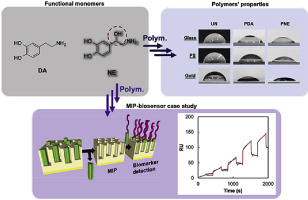Biosensors and Bioelectronics ( IF 10.7 ) Pub Date : 2020-03-20 , DOI: 10.1016/j.bios.2020.112161 V. Baldoneschi , P. Palladino , M. Banchini , M. Minunni , S. Scarano

|
The continuous research for alternatives to antibody-based detection drove, in the last decades, the development of numerous strategies. Molecularly imprinted polymers (MIPs) emerged thanks to the low-cost and long-term stability features, where the choice of natural functional monomer(s) represents the key step for efficient imprinting of biomolecules. The chemical structure of dopamine (DA), one of the most used natural functional monomers, provided the inspiration for this work. We wondered why norepinephrine (NE) that differs from dopamine only for an additional hydroxyl group was not investigated at all in biosensing applications. In fact, there is only one paper exploiting polynorepinephrine (PNE) in molecular recognition applications, taking advantage of molecular imprinting, but not for biosensing purposes. In contrast, hundreds of papers describe polydopamine-based sensors. Therefore, we firstly investigated how the additional hydroxyl group of NE could affect the properties of the resulting polymer, and how these properties could be exploited for biosensing applications. The results highlighted the reduced non-specific adsorption of proteins onto PNE with respect to dopamine polymer. Furthermore, as a case study, we successfully developed a PNE-based imprinted biosensor for the early detection of Troponin I, a crucial biomarker for heart failure, by coupling the MIP biosensor with surface plasmon resonance (SPR) detection. The results indicate the feasible use of imprinted PNE as synthetic receptor for biomolecules, opening new perspectives for this biopolymer, so far not considered, and encouraging further investigations on its potential application in biosensing.
中文翻译:

去甲肾上腺素作为分子印迹的新功能单体:心脏生物标志物的光学传感的应用研究。
在过去的几十年中,对基于抗体的检测替代品的不断研究推动了众多策略的发展。分子印迹聚合物(MIP)的出现是由于其低成本和长期稳定的特性,其中选择天然功能单体是有效印迹生物分子的关键步骤。最常用的天然功能单体之一多巴胺(DA)的化学结构为这项工作提供了灵感。我们想知道为什么在生物传感应用中根本没有研究过不同于多巴胺的去甲肾上腺素(NE)。实际上,只有一篇论文在分子识别应用中利用聚去甲肾上腺素(PNE)来利用分子印迹,但并非用于生物传感目的。相反,数百篇论文描述了基于聚多巴胺的传感器。因此,我们首先研究了NE的额外羟基如何影响所得聚合物的性能,以及如何将这些性能用于生物传感应用。结果强调了相对于多巴胺聚合物,蛋白质在PNE上的非特异性吸附减少了。此外,作为案例研究,我们通过将MIP生物传感器与表面等离振子共振(SPR)检测结合起来,成功开发了一种基于PNE的印迹生物传感器,用于肌钙蛋白I(心衰的关键生物标志物)的早期检测。结果表明,印记的PNE作为生物分子的合成受体的可行用途,为这种生物聚合物开辟了新的前景,迄今为止尚未被考虑,









































 京公网安备 11010802027423号
京公网安备 11010802027423号